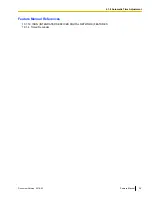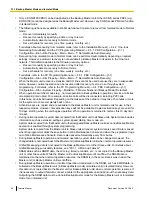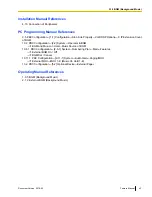
Explanation:
As shown in the CDPG table above, CDPG 1 consists of Port 1 of the first card and Port 1 of the second card.
When "1023-456-7890" (leading number: 10) is dialed:
The leading number (10) is
searched for in the Hunt Pattern
Table.
CDPG 1 is the 1st priority
CDPG.
The call is routed to
Port 1 of the first card.
The call is rerouted to
Port 1 of the second
card.
Port 1 of the first card
is busy.
Port 1 of the second
card is available.
The call is
answered.
If all the ports belonging to CDPG 1 are busy, the call is rerouted to the lowest-numbered available port
belonging to CDPG 4, which is set as the second priority for this leading number.
Installation Manual References
PC Programming Manual References
Feature Manual References
15.1.23 Private Network Features—VoIP (Voice over Internet Protocol)
4.1.3 Caller ID
Description
The PBX can receive Caller ID information (a caller’s name and telephone number) from calls received on CO
lines. This information can be shown on a proprietary telephone (PT) display when receiving a call and can be
used to direct calls from specific callers to specific destinations automatically. Additionally, Caller ID information
is logged in the Incoming Call Log of the extension which received the call, allowing the caller to view a record
of incoming calls or make a call to a person in the call log later.
The PBX can be programmed to modify a caller’s telephone number when it is received and, for example, add
a CO Line Access number or add/delete certain digits of incoming telephone numbers automatically. This
allows an extension user to be able to make a call later to a telephone number logged in his or her call log
without worrying about CO Line Access numbers, area codes, etc.
Note
•
The term "Caller ID" used in this Feature Manual refers to features that can receive caller information
sent from the telephone company and received on analog and ISDN lines. Your network provider may
use a different name for this type of service.
•
To receive Caller ID information, you must subscribe to the telephone company’s Caller ID service and
enable Caller ID for the appropriate CO line through system programming.
Caller ID to SLT Port:
Caller ID information can also be shown on a single line telephone (SLT) display. This feature is available only
for SLTs compatible with FSK-type Caller ID.
48
Feature Manual
Document Version 2016-03
4.1.3 Caller ID
Summary of Contents for KX-NS1000
Page 15: ...Section 1 For Your Safety Document Version 2016 03 Feature Manual 15...
Page 18: ...18 Feature Manual Document Version 2016 03 1 1 1 For Your Safety...
Page 19: ...Section 2 Features and Configurations A Document Version 2016 03 Feature Manual 19...
Page 36: ...36 Feature Manual Document Version 2016 03 2 1 8 Automatic Time Adjustment...
Page 37: ...Section 3 Features and Configurations B Document Version 2016 03 Feature Manual 37...
Page 44: ...44 Feature Manual Document Version 2016 03 3 1 2 BGM Background Music...
Page 45: ...Section 4 Features and Configurations C Document Version 2016 03 Feature Manual 45...
Page 89: ...Section 5 Features and Configurations D Document Version 2016 03 Feature Manual 89...
Page 122: ...122 Feature Manual Document Version 2016 03 5 1 18 DSP Resource Usage...
Page 123: ...Section 6 Features and Configurations E Document Version 2016 03 Feature Manual 123...
Page 137: ...Section 7 Features and Configurations F Document Version 2016 03 Feature Manual 137...
Page 159: ...Section 8 Features and Configurations G Document Version 2016 03 Feature Manual 159...
Page 165: ...Section 9 Features and Configurations H Document Version 2016 03 Feature Manual 165...
Page 172: ...172 Feature Manual Document Version 2016 03 9 1 6 Hot Line...
Page 173: ...Section 10 Features and Configurations I Document Version 2016 03 Feature Manual 173...
Page 217: ...Section 11 Features and Configurations K Document Version 2016 03 Feature Manual 217...
Page 220: ...220 Feature Manual Document Version 2016 03 11 1 1 KX UT Series SIP Phones...
Page 221: ...Section 12 Features and Configurations L Document Version 2016 03 Feature Manual 221...
Page 228: ...228 Feature Manual Document Version 2016 03 12 1 4 Local Alarm Information...
Page 229: ...Section 13 Features and Configurations M Document Version 2016 03 Feature Manual 229...
Page 237: ...Section 14 Features and Configurations O Document Version 2016 03 Feature Manual 237...
Page 252: ...252 Feature Manual Document Version 2016 03 14 1 9 Operator Features...
Page 253: ...Section 15 Features and Configurations P Document Version 2016 03 Feature Manual 253...
Page 331: ...Section 16 Features and Configurations Q Document Version 2016 03 Feature Manual 331...
Page 333: ...Section 17 Features and Configurations R Document Version 2016 03 Feature Manual 333...
Page 340: ...340 Feature Manual Document Version 2016 03 17 1 3 Room Status Control...
Page 341: ...Section 18 Features and Configurations S Document Version 2016 03 Feature Manual 341...
Page 364: ...364 Feature Manual Document Version 2016 03 18 1 12 Syslog Record Management...
Page 365: ...Section 19 Features and Configurations T Document Version 2016 03 Feature Manual 365...
Page 385: ...Section 20 Features and Configurations U Document Version 2016 03 Feature Manual 385...
Page 443: ...Section 21 Features and Configurations V Document Version 2016 03 Feature Manual 443...
Page 448: ...448 Feature Manual Document Version 2016 03 21 1 2 Virtual PS...
Page 449: ...Section 22 Features and Configurations W Document Version 2016 03 Feature Manual 449...
Page 459: ...Section 23 Appendix Document Version 2016 03 Feature Manual 459...
Page 481: ...Document Version 2016 03 Feature Manual 481 Notes...















































